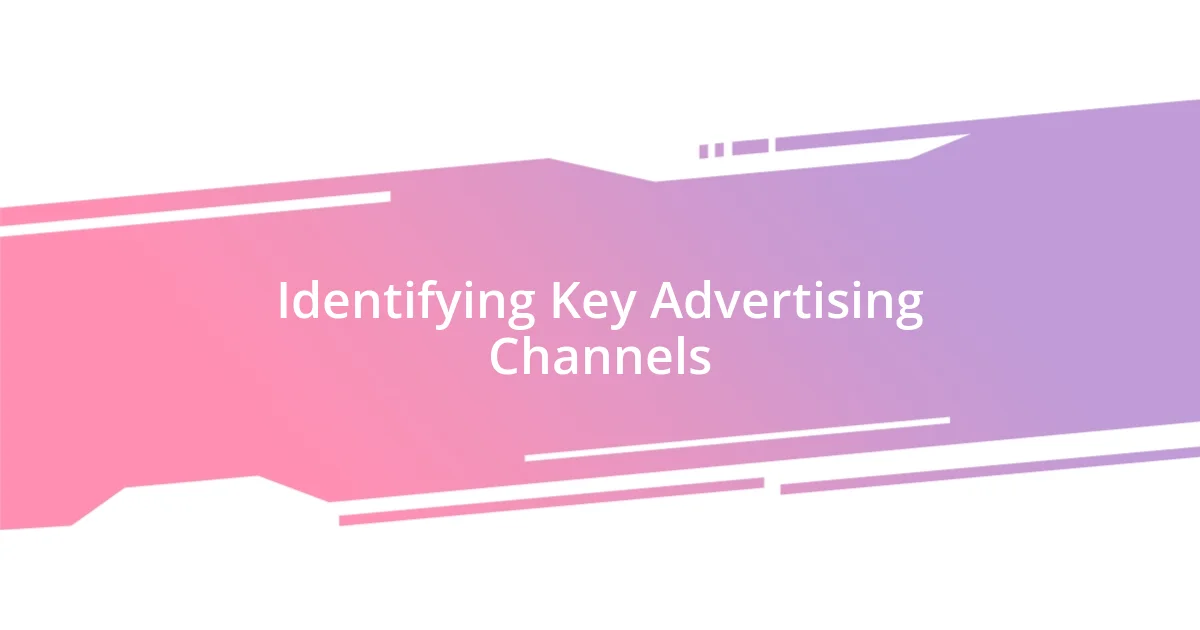Key takeaways:
- Analyzing competing ads uncovers insights into their strengths and weaknesses, fostering creativity and a competitive edge.
- Identifying the most effective advertising channels through performance metrics is crucial for optimizing campaign results.
- Leveraging audience insights and A/B testing enhances engagement by tailoring messaging and content to resonate with diverse demographics.

Understanding Competing Ads Importance
Understanding the importance of competing ads can truly transform your marketing strategy. I remember a time when I launched a campaign without analyzing my competitors. It felt like trying to navigate a maze blindfolded. Understanding what others in your space are doing not only helps you identify gaps but also sparks creativity in crafting unique messages that resonate with your audience.
When I delve into competing ads, I find that it exposes not just their strengths but also their weaknesses. Have you ever noticed a competitor’s ad that seemed off or misplaced? These moments are goldmines—they highlight what not to do and can steer your efforts in a more effective direction. Adopting a mindset that views competing ads as learning opportunities can elevate your own campaigns significantly.
Furthermore, analyzing competing ads fosters a competitive edge in an overcrowded market. I’ve seen brands lose potential customers simply because they became complacent. By regularly examining your competition’s strategies, you not only stay relevant but also innovate. Isn’t it exciting to think that understanding what others do could lead to your unique breakthrough? The interplay of awareness and action is vital in this dynamic landscape.

Analyzing Competitor Advertising Strategies
When I analyze competitor advertising strategies, I often look for the patterns and tactics that seem to resonate with their audience. It’s fascinating how one brand’s success can inspire innovative ideas in my own campaigns. For instance, I once encountered a competitor’s ad that cleverly used humor to showcase their product. This sparked an epiphany for me, prompting me to explore how humor could make my messages more relatable and engaging.
Here are some key aspects I focus on when analyzing competitor ads:
- Target Audience Engagement: Understanding how competitors connect with their audience emotionally.
- Visual Elements: Noticing the choice of colors, fonts, and imagery that convey their brand message.
- Call-to-Action: Evaluating the effectiveness of prompts that encourage customer engagement.
- Content Format: Observing the types of content they use (videos, infographics, stories) and their impact.
- Accountability: Tracking whether their ads maintain consistency across different platforms.
I cherish these insights as they fuel my creativity and help me remain agile in a rapidly changing marketing scene.

Identifying Key Advertising Channels
Identifying the right advertising channels can make or break a campaign. I remember a time when I took the leap into online advertising without carefully evaluating which platforms suited my audience best. The result? A lot of effort with minimal returns. Now, I focus on where my target demographic spends their time; understanding these preferences transforms my advertising strategy.
Each advertising channel offers unique benefits and audiences. Social media, for instance, allows for immediate engagement and real-time feedback, which I find invaluable. On the other hand, traditional mediums like TV ads can provide broader reach but often lack the targeted effort that digital platforms can offer. It’s an ongoing balance of exploring what resonates best with the audience and adjusting accordingly.
To effectively identify key advertising channels, I compare performance metrics from various platforms. For example, I once realized that my Facebook ads were outshining my Google AdWords, leading me to reallocate my budget. This hands-on experimentation taught me that analytics are my best friend, guiding me to invest wisely where I see engagement and conversion rates thrive.
| Advertising Channel | Strengths |
|---|---|
| Social Media | Immediate engagement, targeted audience reach |
| TV Advertising | Wide reach, brand storytelling |
| Email Marketing | Cost-effective, direct communication |
| Search Engine Ads | Intent-driven traffic, measurable results |

Assessing Target Audience Engagement
When it comes to assessing target audience engagement, I often find myself diving deep into the emotional triggers that competitors employ. I remember a time I saw a brand’s ad that made me feel nostalgic, tapping into cherished memories that instantly connected me to their product. It’s a reminder that hitting the right emotional note can significantly skyrocket engagement—what emotions does your audience hold dear?
Monitoring engagement metrics is one of my go-to strategies. For example, I once analyzed a competitor’s campaign that had a high rate of shares and comments compared to others. I learned that their success lay in creating content that sparked conversations, making me rethink how I approach my ads. It begs the question: how can we cultivate that kind of interactive dialogue with our audience?
I also like to observe the feedback loop created by audience responses. After launching one of my campaigns, I took note of the comments and reactions, realizing that real-time engagement could steer my next steps. Connecting with the audience isn’t just about pushing products; it’s about genuinely listening to what they have to say. Have you ever considered how their feedback can direct your future campaigns?

Evaluating Ad Performance Metrics
Evaluating ad performance metrics is crucial for refining campaign strategies. In my experience, I’ve often felt overwhelmed by the multitude of data available. However, focusing on key performance indicators (KPIs) like click-through rates (CTR) and conversion rates has allowed me to pinpoint what truly matters. For instance, during one campaign, I realized that a high CTR didn’t always translate into sales, prompting me to adjust my approach.
Delving deeper into metrics also revealed interesting patterns. One time, I noticed that ads run during specific hours generated much higher engagement, suggesting that timing can significantly impact performance. It was an eye-opener, reminding me that understanding the rhythm of my audience’s behavior could position my ads for success. Have you ever analyzed whether your ads are hitting the right audience when they’re most active?
Ultimately, regularly revisiting performance metrics gives me a sense of how my efforts are paying off. A particular instance stands out: I compared the ad performance of a new product launch against an established one. While the new launch had good initial traffic, the metric showed that staying power was lacking. This insight helped me pivot my messaging to ensure continued engagement. It’s fascinating how numbers can tell a story of their own, isn’t it?

Leveraging Insights for Your Campaigns
Leveraging insights is the heart of effective advertising campaigns. I’ve noticed that when I dive into audience data, I often stumble upon trends I hadn’t recognized before. For instance, while analyzing responses from a recent ad, I found that incorporating user-generated content not only boosted engagement but also made the audience feel like they were part of the brand story. Have you thought about how valuable your audience’s contributions can be to your campaigns?
It’s also essential to adapt your strategies based on these insights. I remember a time when a particular ad seemed to resonate with viewers due to its relatable humor. However, after digging deeper, I found that different segments of my audience were engaging with diverse messaging styles. This knowledge transformed my approach, allowing me to tailor content that spoke to various demographics. Do you consider the diverse voices within your audience when crafting your messages?
Furthermore, I frequently rely on insights for A/B testing different approaches. I once ran two versions of an ad, changing just a small detail, and the results were eye-opening. One version generated twice the engagement of the other, merely because it tapped into a trending topic. This experience taught me the power of small adjustments and continuous testing. What experiments have you conducted to discover what truly resonates with your target audience?














